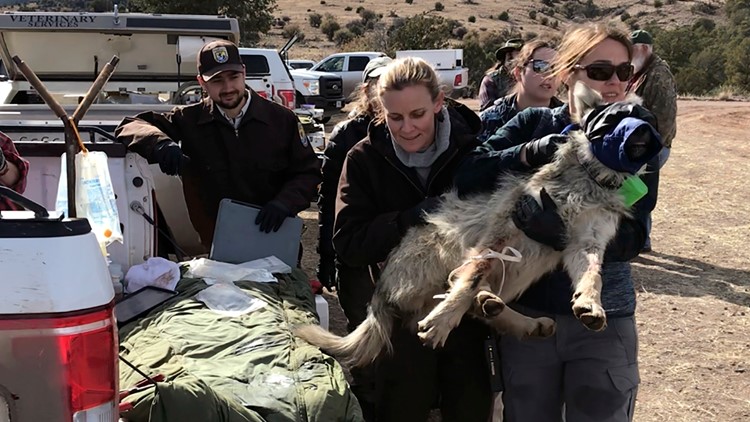An environmental group is raising questions about investigations into livestock kills by Mexican gray wolves in the southwestern U.S.
The Western Watersheds Project has documented oddities, errors or conflicting details in more than two-thirds of the 117 investigations it reviewed from 2019. The investigations are used to compensate ranchers for cattle that are killed in Arizona and New Mexico.
Greta Anderson, the group's deputy director, said she found numerous cases that were deemed to be “confirmed” wolf kills were based on what she described as logical leaps and a stunning lack of evidence.
Wolves may be paying for such inaccuracies with their lives, she said.
In March alone, government hunters killed four wolves in New Mexico under federal removal orders that cited repeated attacks on livestock in the area.
“We want to make sure if wolves are being blamed that it’s true,” Anderson said told the Arizona Daily Star. “We have a lot of questions. We don’t have a bunch of conclusions.”
In one case, the remains of a dead cow were found last year in the bottom of a canyon near Reserve, New Mexico. All that was left was a wadded scrap of dried hide that investigators photographed and then collected. They soaked the skin for weeks before it was soft enough for them to find tooth marks on it.
The size of the bite and the location of the hide was all the federal government needed to confirm this 4-year-old cow was killed by a wolf.
The Mexican gray wolf was once common throughout portions of the Southwest and Mexico. By the 1970s, it had been hunted, trapped and poisoned to near-extinction.
In 1998, state and federal wildlife managers began reintroducing the subspecies with the experimental release of 11 captive-bred wolves. There are now at least 163 wolves roaming the two states, according to the latest survey.
The recovery program is a cooperative effort by nine federal, state and tribal agencies. The U.S. Fish and Wildlife Service leads the interagency team. The Wildlife Services branch of the U.S. Department of Agriculture investigates livestock deaths and removes wolves when necessary.
Wildlife Services spokeswoman Tanya Espinosa said the agency tries to conduct its investigations within 24 hours of being notified of a livestock kill.
The agency received funding this year to hire conflict prevention specialists. Some of that work will focus on wolf conflicts, she said.
Last year marked a record for livestock kills, and officials say this year is on a similar pace. In April alone, more than two dozen livestock kills were confirmed.
Brady McGee, the Mexican wolf recovery coordinator for the Fish and Wildlife Service, said New Mexico's Gila National Forest offers some of the best wolf habitat and grazing goes on there year-round.
While a number of factors go into deciding whether to catch or kill a wolf, McGee said the basis of the removal orders are due to wolf-livestock conflicts. Removal is a last resort, he said.
“We try to find a balance and alleviate the impact on the livestock industry as much as possible,” he said.
Western Watersheds doesn't believe wolves should be killed for preying on prey on public lands, Anderson said. “It’s really the livestock operators that are the problem for wolves, not the other way around.”
So far, the environmental group has received almost 2,600 pages of federal investigation reports through a public records request filed last year. The purpose of getting the documents was to analyze livestock losses in search of patterns, problem areas and possible solutions to prevent future conflicts.
They also hoped to use location data for specific packs to evaluate management decisions being made by the federal caretakers.
Citing privacy and other concerns, the government redacted details, including the names of investigators and the ranchers involved. Also blacked out were the locations where the dead animals were found and other details that would identify specific livestock operations.
With wolves evenly distributed between Arizona and New Mexico, Anderson asked why there so many more confirmed livestock kills in New Mexico, particularly in Catron County, a hotbed of opposition to wolf recovery efforts.
She theorized that local politics was influencing investigations and that blaming wolves for every livestock loss was a way to sabotage the recovery effort by convincing policy makers that the program is hurting rural residents.
Catron County conducts its own investigations using a dedicated investigator employed by the sheriff’s office — the only county in New Mexico or Arizona that does so. County officials have taken a hard-line stance against wolf reintroduction, passing emergency ordinances that broadly define what a “problem predator” is and allow deputies to kill wolves that pose an imminent threat to people.
McGee said the majority of the wolves living in New Mexico can be found in Catron County, though that might not entirely explain why so many of the livestock attacks happen there. He said there are “depredation hot spots," but elsewhere other wolf packs and livestock roam the same land with little to no conflicts.
“We haven’t figured that out yet,” he said.
Anderson acknowledged that even the best management practices can’t completely eliminate livestock losses, and that's why thorough investigations are important.
She said it’s the only way to identify real, ongoing conflicts and ensure that wolf packs are not being unfairly blamed — and punished — for attacks by other predators, including coyotes, feral dogs, bears and mountain lions.



